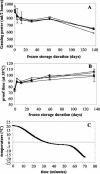Aquaporin-mediated improvement of freeze tolerance of Saccharomyces cerevisiae is restricted to rapid freezing conditions
- PMID: 15184134
- PMCID: PMC427737
- DOI: 10.1128/AEM.70.6.3377-3382.2004
Aquaporin-mediated improvement of freeze tolerance of Saccharomyces cerevisiae is restricted to rapid freezing conditions
Abstract
Previous observations that aquaporin overexpression increases the freeze tolerance of baker's yeast (Saccharomyces cerevisiae) without negatively affecting the growth or fermentation characteristics held promise for the development of commercial baker's yeast strains used in frozen dough applications. In this study we found that overexpression of the aquaporin-encoding genes AQY1-1 and AQY2-1 improves the freeze tolerance of industrial strain AT25, but only in small doughs under laboratory conditions and not in large doughs under industrial conditions. We found that the difference in the freezing rate is apparently responsible for the difference in the results. We tested six different cooling rates and found that at high cooling rates aquaporin overexpression significantly improved the survival of yeast cells, while at low cooling rates there was no significant effect. Differences in the cultivation conditions and in the thawing rate did not influence the freeze tolerance under the conditions tested. Survival after freezing is determined mainly by two factors, cellular dehydration and intracellular ice crystal formation, which depend in an inverse manner on the cooling velocity. In accordance with this so-called two-factor hypothesis of freezing injury, we suggest that water permeability is limiting, and therefore that aquaporin function is advantageous, only under rapid freezing conditions. If this hypothesis is correct, then aquaporin overexpression is not expected to affect the leavening capacity of yeast cells in large, industrial frozen doughs, which do not freeze rapidly. Our results imply that aquaporin-overexpressing strains have less potential for use in frozen doughs than originally thought.
Figures



Similar articles
-
Aquaporin expression correlates with freeze tolerance in baker's yeast, and overexpression improves freeze tolerance in industrial strains.Appl Environ Microbiol. 2002 Dec;68(12):5981-9. doi: 10.1128/AEM.68.12.5981-5989.2002. Appl Environ Microbiol. 2002. PMID: 12450819 Free PMC article.
-
Overexpression of the calcineurin target CRZ1 provides freeze tolerance and enhances the fermentative capacity of baker's yeast.Appl Environ Microbiol. 2007 Aug;73(15):4824-31. doi: 10.1128/AEM.02651-06. Epub 2007 Jun 8. Appl Environ Microbiol. 2007. PMID: 17557846 Free PMC article.
-
Importance of Proteasome Gene Expression during Model Dough Fermentation after Preservation of Baker's Yeast Cells by Freezing.Appl Environ Microbiol. 2018 May 31;84(12):e00406-18. doi: 10.1128/AEM.00406-18. Print 2018 Jun 15. Appl Environ Microbiol. 2018. PMID: 29625985 Free PMC article.
-
Functional relevance of water and glycerol channels in Saccharomyces cerevisiae.FEMS Microbiol Lett. 2017 May 1;364(9). doi: 10.1093/femsle/fnx080. FEMS Microbiol Lett. 2017. PMID: 28430948 Review.
-
Characterization of a new set of mutants deficient in fermentation-induced loss of stress resistance for use in frozen dough applications.Int J Food Microbiol. 2000 Apr 10;55(1-3):187-92. doi: 10.1016/s0168-1605(00)00162-8. Int J Food Microbiol. 2000. PMID: 10791742 Review.
Cited by
-
Inhibition of aquaporins as a potential adjunct to breast cancer cryotherapy.Oncol Lett. 2021 Jun;21(6):458. doi: 10.3892/ol.2021.12719. Epub 2021 Apr 8. Oncol Lett. 2021. PMID: 33907568 Free PMC article.
-
Microbial membrane transport proteins and their biotechnological applications.World J Microbiol Biotechnol. 2024 Jan 16;40(2):71. doi: 10.1007/s11274-024-03891-6. World J Microbiol Biotechnol. 2024. PMID: 38225445 Free PMC article. Review.
-
Design and characterization of genetically engineered zebrafish aquaporin-3 mutants highly permeable to the cryoprotectant ethylene glycol.BMC Biotechnol. 2011 Apr 8;11:34. doi: 10.1186/1472-6750-11-34. BMC Biotechnol. 2011. PMID: 21477270 Free PMC article.
-
Less Is More, Natural Loss-of-Function Mutation Is a Strategy for Adaptation.Plant Commun. 2020 Aug 13;1(6):100103. doi: 10.1016/j.xplc.2020.100103. eCollection 2020 Nov 9. Plant Commun. 2020. PMID: 33367264 Free PMC article. Review.
-
Cold-loving microbes, plants, and animals--fundamental and applied aspects.Naturwissenschaften. 2007 Feb;94(2):77-99. doi: 10.1007/s00114-006-0162-6. Epub 2006 Oct 13. Naturwissenschaften. 2007. PMID: 17039344 Review.
References
-
- Attfield, P. V., A. Raman, and C. J. Northcott. 1992. Construction of Saccharomyces cerevisiae strains that accumulate relatively low concentrations of trehalose and their application in testing the contribution of the disaccharide to stress tolerance. FEMS Microbiol. Lett. 94:271-276. - PubMed
-
- Bonhivers, M., J. M. Carbrey, S. J. Gould, and P. Agre. 1998. Aquaporins in Saccharomyces—genetic and functional distinctions between laboratory and wild-type strains. J. Biol. Chem. 273:27565-27572. - PubMed
-
- Brachmann, C. B., A. Davies, C. J. Cost, E. Caputo, J. Li, P. Hieter, and J. D. Boeke. 1998. Designer deletion strains derived from Saccharomyces cerevisiae S288C: a useful set of strains and plasmids for PCR-mediated gene disruption and other applications. Yeast 14:115-132. - PubMed
-
- Calcott, P. H., and A. H. Rose. 1982. Freeze-thaw and cold-shock resistance of Saccharomyces cerevisiae as affected by plasma membrane lipid composition. J. Gen. Microbiol. 128:549-555.
-
- Cho, Y. S., M. Svelto, and G. Calamita. 2003. Possible functional implications of aquaporin water channels in reproductive physiology and medically assisted procreation. Cell. Mol. Biol. 49:515-519. - PubMed
Publication types
MeSH terms
Substances
LinkOut - more resources
Full Text Sources
Molecular Biology Databases

